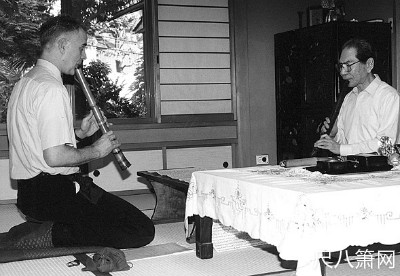转:声音的投资--尺八学费知多少 Sound Investment - 2001年文章

(遥盟(CHRISTOPHER Y. BLASDEL )与他的老师-已故人间国宝 - 山口五郎)
虽然这是一篇几年前的文章,但对学习尺八古曲的人,还是具有一定程度的参考价值. 其内容并不随时间改变而有所不同,粗略翻译后,贴上来供大家参考.
会想把这篇文章翻译出来,主要是网站上谈到{尺八学费}的文章太少了,对许多日本人来说都太敏感了,特别是对那些已成名的演奏家更是不见提及,上课的老师会私下告诉你,上他的课一堂课多少钱,但比较不常提到他的老师收他多少钱. 这点倒是比较容易理解,毕竟影响上课金额多寡的因素还蛮多的. 许多来台湾演出的小提琴名家,经常会有所谓的"大师课程",不是免费就是天价.自由市场,收取多少费用,理所当然不会是公定价格是正常现象.
欧美的网页比较容易见到明确的课堂费用,而且这篇文章给了一个蛮吓人,但相信对作者遥盟(CHRISTOPHER Y. BLASDEL )而言是一个蛮真实的数字,也可以说对于有兴趣向山口五郎或其他大师学习琴古流尺八的人,都是一个值得参考的数字.
作者提到的金额,并不包括购买昂贵尺八的费用,而这些人当中,大概没有人是一支尺八行遍天下,大部份都拥有"一堆"尺八. 有些门派,不同曲目使用不同长度吹奏,虽然没有"立法严格"规定,但几乎已成通则,许多合奏场合,更是需要长短不一各种调性的尺八. 这些尺八做的差的,上不了台,音准,音量,音色过的去的,价格绝对不会太便宜.要注意的是,买尺八的费用并不列入.有趣的是,大部分的人,买尺八并不手软,但提到"学费",则是能省则省. 当然,人各有志,无法强求,也无所谓对错,课程是软体,尺八本身可归类为硬体,其实缺一不可.
总之,林林总总的加起来,这个费用远超过我们一般人的想像,有时也可以体会到为什麽"尺八""筝""三味线"等等归属于"邦乐"的东西. 这些东西,如果真要从儿提时学起,可能要耗费巨资,如果你有计算机,建议你按照他说的按按计算机,你会发现其所言不虚.
如同之前几篇文章所提到,金额,修业完成的时间不是一成不变,每个流派有不同的运作模式.每个人花费的时间也不尽然相同.有难有易,状况不一,好坏难以论断.在日本国内,因牵涉公众评价,尺八老师比较不敢让有违常理之事发生,特别是在其日本国内,但从美国网站的讨论栏中,可以见到远离日本之后,许多国外尺八老师为了生存,不免会做出一些匪夷所思的事,这些事在日本是笑话一则.虽然其心可议,为了生存,却也其情可悯.以前虽也辗转听过证书资格买卖的事发生,却没能亲眼目睹.
在日本,修业之初,最常见一个星期上一次课,有人因地点关系,可能採取一个月上一次课,有些"在日本停留时间"有限时压力的外国人,一星期可能上3次课,弹性很大,可依自己的学习规划考量上课的方式. 这篇文章所提到的金额并非绝对,可能较低,也可以较高. 在都会区,许多老师以尺八教学为主,课程时间可能较具弹性,一星期有数天.较偏远地区,许多老师很难单以尺八教学为生,尺八师资,学生有限的情况下,尺八教学变成下班后,或价假日时的副业,一星期可能只有1~2天内的特定时段有教学课程.
这几年看过的实际上,或网页上的价格有5000円/1次,或一个月5000円/2次, 10000円/3~4次, 7000円/2次,也听说过15000円/1次.,在欧美,一堂课金额约在USD40~80不等...........什麽样的金额都有,向{谁}学习,决定学费的负担多寡.不可否认,其中包含{以价制量}的考量,否则如果是公定价格,以日本的尺八学习人口而言,那些知名的大师们会忙到没时间吃饭,睡觉.有些老师,一个月3000円,可能都还找不到学生.
也听说过,在都山流,不同的程度(等级)的学生,上课的费用也是不同.等级愈高,曲目愈难,学费愈贵.但这些差异,也要看老师的知名度,与学生的多寡而定吧!
以遥盟(CHRISTOPHER Y. BLASDEL )这篇文章所提到其完成所有课程时间约6年,当然,时间有长有短,没有绝对,各门派并不相同. (实际上 遥盟(CHRISTOPHER Y. BLASDEL )是于1972年开始向 山口五郎学习尺八,在1984年取得遥盟的名字,前后花了12年时间取得师范教学资格. 同时期也完成日本东京艺术大学的音乐学位,这段时间也多次代表日本文化单位前往国外表演,并取得日本的永久居留权. )
如以遥盟所提到的6年课程次数来算,学生每周上课一次,连续6年,上课次数 52次/年 x 6年 = 312 次.
如果 (1) 15000日币/月 X 12月 X 6 年 = 1,080,000. (约台币324,000.)
如果(2) 25,000. 日币/月 X 12月/年 X 6年 = 1,800,000. (约台币540,000.)
2001年2月17日 山口五郎的学生遥盟(CHRISTOPHER Y. BLASDEL )替JapanTimes网路新闻网站写了一篇有关尺八的报导.记得第一次看到他的文章是第一次到日本时,在{目白}英文型录裡,夹著一张,遥盟写的一篇{纪念山口五郎的报导-英文版},后来也买了它的教学书籍.
其实{遥盟}除了替这个网站,也替许多杂志报纸写过许多有关日本文化,特别是{邦乐}方面的文'章,遥盟自己也出过几本书,尺八教学的英日文教材,尺八学习历程的自传-The single tone.等,感觉上,遥盟除了是一位知名的专业尺八演奏家,也是一位作家.
< >
http://www.japantimes.co.jp/
JapanTimes的几篇尺八的报导 (点击后进入JapanTimes的尺八相关英文网页)
Everything you need to know to make a sound investment (By CHRISTOPHER Y. BLASDEL)
声音的投资-你需要知道的每一件事
在日本--用最传统方式学习日本音乐是一件很有趣的文化飨宴之旅。
它也是昂贵的。
例如,一支由木头製成的初学者尺八,和一些必要的配件,大约要20,000.日元。按不同的老师,包括入会费和每个月的学费,约每个月15,000.~25,000.日元。比较美国,学费大概在相同水平。但有在教学型式、课堂礼节和学生的行为上却有显著区别。体会瞭解这个重点和瞭解日本传统音乐是一样重要的。
在美国-我长大的地方,音乐课程在老师和学生之间,就像契约关系存在著,给钱是很直接的。
在日本,它不是那麽单纯。首先, 不管你是否按时来上课,你都要支付每个月的学费。重点是,学生老师关系不是以金钱为主的知识交换;你支付的是属于老师的私人团体的(特权)费用(注:可能有点像权利金,入会费)。
还有其他的费用,是当你通过某些课程等级时要额外支付的。在日本,一切都必须被允许和被认可(证明)。当学生完成某阶段的学习,并通过老师订定的合格标准,老师也会提供书面证明文件(证书)。它也为老师提供较稳定的收入。
根据困难度,我参加的尺八团体被划分成五个等级。它大概要经过六年完成所有等级的认证,每通过一个等级,学生就会取得一张证书。这些证明的费用从最初级的(初传)50,000日元,到(师范)等级的300,000.日元, 老师给予一个流派的传承名字.这个名字主要用予演奏和教学使用(注:有些像我们说的特许证)。
总而言之, 六年的学习费用加证书大约要二百伍拾万日元(2,500,000.日元,约台币750,000.)。单就尺八的学习课程与证书的取得费用而言,这算是便宜的。
对某些古筝流派(学校)而言,单单取得师范证书和一个师承的名字要花1百万日元。许多的日本传统舞蹈(舞蛹)要求更惊人的费用,不只是课程,还包括辅助配件像舞台用的和服和 (obi?)、假髮、扇子…等。这些通常透过老师购买,当然,老师会得到一定比例的佣金。整年度中还会有各种的吟诵表演节目, 这些花费超过一百万日元(1,000,000.).还有租借表演的场地和伴奏表演者的费用。
透过学生的固定学费,老师或iemoto (流派宗家)可以有较好的财务状况,但老师和流派宗家负担许多看不见的费用。例如,支付即将来临的音乐会或新闻报导的费用。
有一次,在准备为一个音乐会写专栏时,我连络某一专业的邦乐团体,询问一些即将来临音乐会的消息。当我告诉他们,我是Japan Times杂志派来採访的,这个人马上起了疑心,并询问是否有广告费用要支付的问题。我跟他保证, 虽然一些邦乐杂志是有费用的问题,但这不是我们Japan Times杂志社的模式.
但是, 有些新组织,机关儘可能降低邦乐的学习费用, 或者至少使所有的费用清楚和精确。有兴趣者……..
(往下介绍一些便宜的学习场所给住在日本的外国人,与个人翻译这篇文章的重点无关,以下内容省略).
注: 有一次碰到一位艺术学院毕业的学生,正在学习日本的{舞蛹},聊天当中提到在日本,要取得某些著名教授舞蛹老师的师范证书要价2,000,000.日元.也间接证实作者所提到的{证书高于一百万日币}.
而日本筝中,著名的生田流宫城会收费方式.
http://www.shamisen.info/menjo/menjo.html
初传 50000
中传 70000
奥传 80000
皆传 100000
助教 200000
教师 300000
以下版权copyright属Japan Times杂志社所有.
(原文如下)Learning Japanese music in a traditional setting is one of the most interesting and culturally enriching experiences to be had in Japan.
It is also expensive.
For example, an inexpensive beginner's shakuhachi, made from wood, and the necessary accessories can be purchased for around 20,000 yen. Lessons involve an entrance fee and monthly gessha tuition fees, usually 15,000 yen-25,000 yen per month, depending on the teacher. This might seem comparable with fees charged by the top teachers in the United States, but there are striking differences in style, etiquette and the behavior of the student vis a vis the teacher. Learning these points is as important as learning the music.
In America, where I grew up, music lessons are understood as a contractual relationship between the teacher and the student, and payment is straightforward. In Japan, it is not so simple. First of all, one pays the monthly gessha whether one attends the lessons or not. The point is that the student-teacher relationship is not a simple exchange of knowledge for money; one pays for the privilege of belonging to the teacher's group of students.
Then there are the fees one pays for moving up through the ranks. In Japan, everything must be licensed and certified. Providing written proof that a student has passed through a defined instruction period confers legitimacy on the learning process. It also provides a steady income for the teacher.
The shakuhachi music I learned was divided into five levels, according to difficulty. It takes a little over six years to go through all the levels and finish the repertoire, and the student is given a certificate upon completion of each level. The cost of these certificates varies from 50,000 yen for the first level to 300,000 yen for completion of the course and receipt of a teaching license and performing name.
Overall, then, six years of study add up to around 2.5 million yen. And the shakuhachi is one of the least expensive instruments. Some schools of koto charge over 1 million yen for professional certification and a performing name.
Traditional dance requires even greater outlays, not only for lessons but for accessories like stage kimono and obi, wigs, fans, etc. These implements are usually purchased through the teacher who, of course, gets a percentage of the price. There are also the various student recitals held throughout the year; some of these can cost upwards of 1 million yen, depending on the piece, venue and accompanying artists.
A teacher or iemoto (headmaster) with many devoted students can do quite well financially, but teachers and headmasters are also burdened with unseen costs. For example, paying for news coverage of an upcoming concert or event is common.
Once, in researching a concert for this column, I called a certain professional hogaku group to inquire about an upcoming concert. When I told them I was from The Japan Times, the man on the phone suddenly turned suspicious and asked if the group would have to pay for the write-up. I assured him that was not the way this paper operates, though some hogaku magazines to some extent do.
Still, there are new institutions that try to make learning hogaku as easy and inexpensive as possible, or at least make all the costs clear and precise. For those wishing introductory courses, the Asahi Culture Centers in Shinjuku, (03) 3344-1947, and Yokohama, (045) 453-1122, teach various genres of hogaku, including shakuhachi, in English. The Genhoken Academy for hogaku music (covered in this column in April) has two- and three-year courses for those wishing to go professional, as does the NHK Ikuseikai.
The Genhoken also does public concerts of both traditional and contemporary music. These concerts present top professionals performing well-thought-out programs for reasonable prices. Its Feb. 25 concert will feature the school's founder, shamisen player Akiko Nishigata, and many of her colleagues.
"Koten Sakuhin Kenkyu Kai," 1:30 p.m., Feb. 25 at Kioi Small Hall, near JR Yotsuya Station or the Akasaka Mitsuke subway station, (03) 5276-4500. Admission 2,000 yen. For tickets or more information, call Genhoken at (03) 3565-4197 or see the Web site at www.mejiro.com/hogaku/ E-mail: genhouken@biglobe.ne.jp
Keisuke Zenyoji, a young shakuhachi player I've written about before, is one of the best players of the classical honkyoku shakuhachi solo repertory. Recently, however, he has begun to apply his talents to contemporary music as well. He will be performing with kotoist Yuka Hosaka, percussionist Hiroshi Chu Okubo and xylophone player Yoshiko Nakagawa in an upcoming session of original music entitled J-DNA as part of Koto Ward's Tiara Hall series, "New Wave Concert."
摘自台湾山城(王锦德)老师部落格:blog.xuite.net/shakuhachi.taiwan
评论列表: